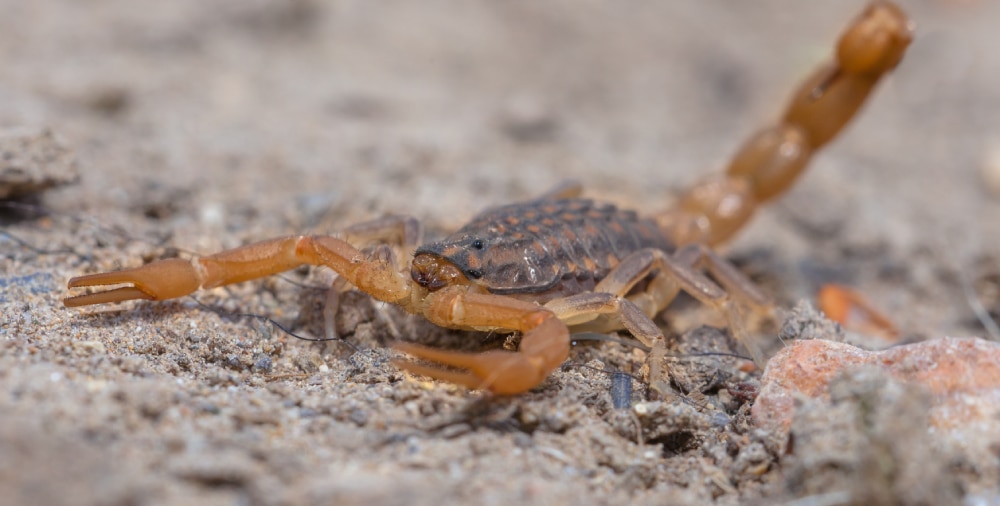Spring is around the corner for hot, dry, and sunny Arizona. That inevitably means more pests roaming the desert and trying to invade your home. One of the most common Arizona pests are scorpions. In fact, according to DesertUSA, Arizona has one of the highest concentrations of scorpions in the United States.
When dealing with scorpions, it’s best to assume that they are poisonous and stay away. This mindset will keep you safe because even though only two U.S. scorpion species are poisonous, all scorpions can still harm you with their sting. Luckily, most scorpion stings aren’t significantly harmful but will only cause pain where someone was stung. Yet, other scorpions can cause numbness, breathing trouble, difficult swallowing, blurry vision, and more. If you’re stung, it’s smart to get medical attention right away.
Scorpion Pest Control Phoenix, AZ
Needless to say, scorpions are a menace to those around them. Especially if they invade your home, you can have a real problem on your hands. You’ll want trustworthy and experienced pest control services like Urban Desert Pest Control. We can quickly handle scorpion and other pest infestations to restore safety and happiness to your home.
In this article, the Urban Desert Pest Control team will offer three things that every Arizona resident should know about Arizona scorpions. The more you know about the pests roaming around, the better protected you can keep your home.
Common Types of Arizona Scorpions
In its desert climate, Arizona is home to a few prominent scorpions. It’s smart to know which ones you can expect to find trying to infiltrate your house.
Arizona bark scorpion. This scorpion is a popular one in The Grand Canyon State because it’s one of the more venomous scorpions found in Arizona. You can distinguish it with its yellowish-tan color and long metasomas (the stinger tail). They’re found around tree bark and reported to be a common home-invading pest.
Arizona striped tail scorpion. The striped tail scorpion is the most common Arizona scorpion. It has a striped dorsal area and is light tan. While they live under rocks, they also find themselves in homes because of the tremendous shelter.
Arizona giant desert hairy scorpion. If the clever name isn’t enough to intimidate you, the giant desert hairy scorpion is the largest scorpion in the United States. Ranging from four to seven inches, this scorpion also has a hairy metasoma. It likes to feast on smaller insects, which sometimes can lead them into a home that’s already pest-ridden.
Scorpions Are Nocturnal
Similar to most pests, scorpions are nocturnal and hunt at night. This means they are more active at night, so that’s likely when they would enter a home. Scorpions enjoy the shade during the day and want this with their shelter. When indoors, they’ll remain in cool, dark areas, such as a basement or attic. Also, scorpions enjoy cluttered areas, including stacks of boxes or clothes.
Signs of a Scorpion Infestation
The most important thing to keep an eye out for is any sign of a scorpion infestation. Evidence of a scorpion problem includes:
- Scorpion droppings. These look like small sand patches.
- Scorpion tracks, such as a smear of tiny pebbles on the ground.
- Scorpion eggs: small Tic Tac candy-like eggs
- Dead scorpions. Bigger pests and even some scorpions will feed on other scorpions, so you could notice those on walls or along baseboards.
- A scorpion itself. This obviously is a simple sign, but this can very well mean that there are more scorpions nearby.
Get Rid of Scorpions and Other Pests with Urban Desert – Contact Us
Urban Desert Pest Control has the tools, chemicals, and training to eradicate any pest control problem. We have provided pest control to the Phoenix area since 2015, and our family-owned business has grown to include over 20 technicians. Urban Desert Pest Control guarantees our work, priding ourselves on superior customer service.
Contact us for a free quote or inspection to keep you, your family, and your home safe.












